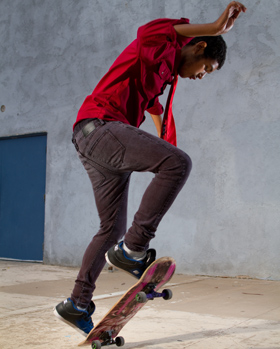Teen at risk for fatty liver disease takes preemptive action
By Josh Baxt

Just one year ago, Fernando weighed more than 290 pounds. When enzyme tests indicated he might be at risk for fatty liver disease, Fernando slimmed down to 160 the old fashioned way: more exercise and fewer calories.
Arce’s mother, Susan, looks at her 16 year-old with a mixture of happiness and concern. “He may be too skinny now,” she says.
Fernando has a new look, and it’s understandable that his family and friends are still adjusting.
Just a year ago, he weighed more than 290 pounds. Now he’s a trim 160. His formerly 44-inch waist is now a 32.
Fernando lost weight the old fashioned way: more exercise and fewer calories. But his motivation was an entirely different story. When enzyme tests indicated he might be at risk for fatty liver disease, he made the decision to slim down — with a vengeance.
He dramatically cut back on chips, tortillas and bread; limited mayonnaise and cheese; did away with ranch dressing and substituted vinegar; and replaced sodas with water.
“Whenever I had a choice between losing normal fat and losing extreme fat, I always chose extreme,” said Fernando.
He joined a fighting gym to study martial arts and boxing.
Each workout included 100 pushups, 200 sit-ups and 300 squats, and that was just the warm-up.
If it seems like Fernando was taking off pounds as if his life were at stake, in a sense, it was.
Fatty liver disease can have dire consequences. Though the name makes it sound like the liver is getting fat, it’s actually the cells that are affected, storing excess fat droplets that impair their function.
This excess cellular fat can be very disruptive, especially in the mitochondria, which provide energy to the cells. In the bigger picture, fatty liver cells can lead to fatty hepatitis; though no infection is involved, fatty hepatitis can create scar tissue (called fibrosis), which can lead to cirrhosis, a potentially fatal condition.
For Fernando, who has a family history of liver cirrhosis, that was all the motivation he needed. Early tests showed he had elevated liver enzymes, and an MRI (magnetic resonance imaging) exam indicated that his liver was enlarged. Though these tests weren’t proof positive he had fatty liver disease, he wasn’t going to wait to find out.
Fernando was referred to Jeffrey Schwimmer, M.D., director of the Fatty Liver Clinic at Rady Children’s Hospital-San Diego and a professor of pediatrics at the University of California, San Diego. Dr. Schwimmer started by laying out the facts about Fernando’s condition.
“For an older teenager, the first goal is to help them understand the issue. Then it’s up to them,” he explained. “Knowing that obesity is a major risk factor for liver disease and knowing his family history, Fernando very much wanted to make some changes.”
His mother has a more personal take. “He didn’t want to be sick anymore,” said Susan. “When Dr.
Schwimmer told him he was going to need a biopsy to check his liver, I think he got scared.”
In addition to his liver issues, Fernando was at risk for type 2 diabetes. But he was also very uncomfortable in his body. He often felt hot, had trouble sleeping and experienced a great deal of anxiety about his weight.
Perhaps the most impressive aspect of Fernando’s weight loss was his methodical approach.
He recognized that he needed to increase activity and cut calories. “A lot of people falsely assume that if they exercise, what they eat doesn’t matter,” said Dr. Schwimmer. “Fernando got it right.”
Working closely with his doctors, Fernando gradually took the weight off — and has kept it off. Though he no longer has time for the fighting gym, he runs most mornings, skateboards in the afternoons and sometimes rides his bike to school. He has learned to control his portion size and cut out most carbohydrates. Most important, Fernando’s health has improved. He is no longer at risk for diabetes and his liver is doing fine.
“I’m so proud of him,” said Susan. “He did it all by himself.”
Originally published in U-T San Diego, October 2012